![]()
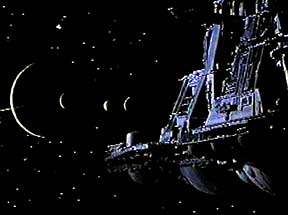 The Nostromo is a M class starship that
is registered to Weyland-Yutani Corporation out of the US state
of Panama. It was refitted to be a commercial towing vehicle in
2116, after that, the Nostromo has largely been employed running
automated ore and oil refineries between the Sol system and 20
Reticuli.
The Nostromo is a M class starship that
is registered to Weyland-Yutani Corporation out of the US state
of Panama. It was refitted to be a commercial towing vehicle in
2116, after that, the Nostromo has largely been employed running
automated ore and oil refineries between the Sol system and 20
Reticuli.
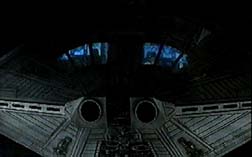 The ships mass, 63,000 metric tons, the
Nostromo's spaceframe is based on a modified Lockmart CM-88B
Bison transporter. The Nostromo is designed to a 6-10-4 layout
with three pressurized decks and four main cargo holds. The spare
volume is taken by the fuel tanking for the fusion reactor and
the reaction mass for the thrust engines. An off-axis hooded
frame mounts the docking latches for the towed cargo. The
Nostromo is sturdy enough of a vehicle to withstand atmospheric
re-entries and for surface landings is supported by three main
landing shocks. The micrometeorite and particulate shielding is
sufficient enough to withstand rough re-entries.
The ships mass, 63,000 metric tons, the
Nostromo's spaceframe is based on a modified Lockmart CM-88B
Bison transporter. The Nostromo is designed to a 6-10-4 layout
with three pressurized decks and four main cargo holds. The spare
volume is taken by the fuel tanking for the fusion reactor and
the reaction mass for the thrust engines. An off-axis hooded
frame mounts the docking latches for the towed cargo. The
Nostromo is sturdy enough of a vehicle to withstand atmospheric
re-entries and for surface landings is supported by three main
landing shocks. The micrometeorite and particulate shielding is
sufficient enough to withstand rough re-entries.
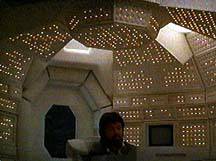 The in-flight systems are all
controlled by the central "Mother"
The in-flight systems are all
controlled by the central "Mother" 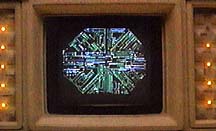 processor. Mother is a 2.1 Terabyte intelligent
mainframe which monitors all of the ship's flight and autonomic
functions. A 2.0 Terabyte backup mainframe comes on line in an
event of a CPU failure, and a third tier of automatics is also
capable of sustaining an autonomic functions should the backup
fail as well.
processor. Mother is a 2.1 Terabyte intelligent
mainframe which monitors all of the ship's flight and autonomic
functions. A 2.0 Terabyte backup mainframe comes on line in an
event of a CPU failure, and a third tier of automatics is also
capable of sustaining an autonomic functions should the backup
fail as well.
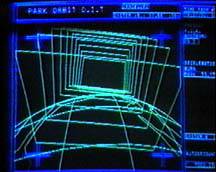 The communications fit is standard, it
compromises of a 10 and 4 meter hyperstate antenna for any
interstellar communications and short-range UHF/VHF/HF
radio/video links.
The communications fit is standard, it
compromises of a 10 and 4 meter hyperstate antenna for any
interstellar communications and short-range UHF/VHF/HF
radio/video links. 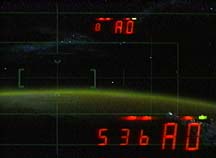 The sensors are mounted on
pylons which are clustered around the forward hull of the ship
and have two 2 m aperture telescopes which are capable of
optical, spectrographic and infrared resolution; a gas
chromagraph; centimetric navigation and landing radar; a
synthetic aperture ground mapping radar; and a mass counter for
supralight navigation.
The sensors are mounted on
pylons which are clustered around the forward hull of the ship
and have two 2 m aperture telescopes which are capable of
optical, spectrographic and infrared resolution; a gas
chromagraph; centimetric navigation and landing radar; a
synthetic aperture ground mapping radar; and a mass counter for
supralight navigation.
The Nostromo's power core is a Laretel WF-15 2.8 Terawatt
fusion reactor. The fusion process is a deuterium/tritium
reaction that can fuse the fuel elements in a containment chamber
using conversion lasers. 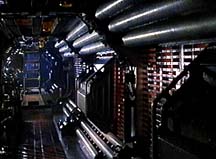 The He4
byproduct of the reaction is kept separately and is vented at
regular intervals. The power is drawn off of the reactor by a
closed-cycle liquid potassium cooling system. Running off into a
induction torus which can use the intense magnetic field created
by the superheated potassium to generate electric power. The ship
may be destroyed by an authorized crewmember by overriding the
reactor cooling system and bleed off coolant, which initiates a
supercritical reaction in the containment area. After the
activation of the self-destruct device, the crew has ten minutes
to get far enough from the ship before it's reactor explodes.
The He4
byproduct of the reaction is kept separately and is vented at
regular intervals. The power is drawn off of the reactor by a
closed-cycle liquid potassium cooling system. Running off into a
induction torus which can use the intense magnetic field created
by the superheated potassium to generate electric power. The ship
may be destroyed by an authorized crewmember by overriding the
reactor cooling system and bleed off coolant, which initiates a
supercritical reaction in the containment area. After the
activation of the self-destruct device, the crew has ten minutes
to get far enough from the ship before it's reactor explodes.
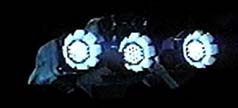 The supralight drive is a Yutani T7A
NLS tachyon shunt which is capable of unladen high cruise up to
0.42 ly per sidereal day (153 cee). When it is towing large
amounts of cargo such as automated refineries, the maximum
sustainable cruise speed drops radically, about 0.1-0.12 ly per
sidereal day (40-45 cee). For maneuvering at sublight speeds when
towing large amounts of cargo, the immensely powerful mass
reaction engines are required. On the Nostromo, the original
Saturn J-3000 engines have been replaced to two Rolls-Royce N66
Cyclone thrust tunnels with bipolar vectoring for midline lifting
functions. Each of the powerplants develop a 65,830 metric ton of
thrust, using water for reaction mass. When running wide open,
both of the engines give a high impulse thrust totaling of
131,660 kN.
The supralight drive is a Yutani T7A
NLS tachyon shunt which is capable of unladen high cruise up to
0.42 ly per sidereal day (153 cee). When it is towing large
amounts of cargo such as automated refineries, the maximum
sustainable cruise speed drops radically, about 0.1-0.12 ly per
sidereal day (40-45 cee). For maneuvering at sublight speeds when
towing large amounts of cargo, the immensely powerful mass
reaction engines are required. On the Nostromo, the original
Saturn J-3000 engines have been replaced to two Rolls-Royce N66
Cyclone thrust tunnels with bipolar vectoring for midline lifting
functions. Each of the powerplants develop a 65,830 metric ton of
thrust, using water for reaction mass. When running wide open,
both of the engines give a high impulse thrust totaling of
131,660 kN.
The lifesystems comprise of three decks, which include the bridge, crews quarters, and dining area. Others include the science station, the CPU module, medical bays, four main cargo bays, storing areas, and the engineering stations. All of these compromise 1.1 million cubic meters of pressurized volume, including all of the air ducts and the air scrubbing plant. The Nostromo has a crew of seven-Ship's Master, First Officer, Executive Officer, Navigation Officer, Science Officer, Chief Engineer, and Engineer's Mate. There are seven hypersleep capsules that have been installed for any long-duration flight. The polarized gravity generators provide the internal gravity and the internal dampening. Beneath the hull, is an external docking bay for a shuttlecraft. The shuttlecraft is capable of being a lifeboat in the case of a ship's evacuation is necessary.
Written by RAY FINCHAM. (rayden22@juno.com)